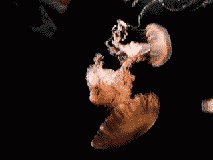
HOME
What's New?
Useful Sites
Visitor's Authority
Palau Map
Miscellanious Sites
Preservation Society
Getting Around
KB Bridge
Diving Tips
The Famous Blue Corner
Living Legacy
Being A Palauan
Proverbs
Palauan Horoscope
Personal Homepages
The Cube
Palauan Links
About YDKDY

 Seen from the top of it's broad platform, a coral reef is a brownish barrier, cut with crevices and potholes, uninteresting in appearance. Viewed closely, it is a multi-colored wonderland, pulsating with life. It's laggon side often tapers into a sandy bottom studded with rocks and grassed with marine weeds and vines. Dun-colored or electric blue anemones wave pastel tentacles at passing small fish, stinging and consuming the unwary ones that wander too close. Black or red sea urchins nestle in rocky niches, their quill-like spines projecting like electrified hair.
Seen from the top of it's broad platform, a coral reef is a brownish barrier, cut with crevices and potholes, uninteresting in appearance. Viewed closely, it is a multi-colored wonderland, pulsating with life. It's laggon side often tapers into a sandy bottom studded with rocks and grassed with marine weeds and vines. Dun-colored or electric blue anemones wave pastel tentacles at passing small fish, stinging and consuming the unwary ones that wander too close. Black or red sea urchins nestle in rocky niches, their quill-like spines projecting like electrified hair. |
At night, accrodion-like seaworms extend themselves across the bottom, snuffling for food. On the bottom, too, sea cucumbers lie lumpishly, looking like a texture version of their namesake. Black or warty, grey or leopard-spotted, these creatures when disturbed emit sticky filaments that can be used as glue. Edible, they once were an important item of trade. Chinese cooks bought the dried skin for use in making soup, and clipper ships conducted a flourishing business of transporting the sea cucumbers from the islands to the Orient. The calm waters of the inner side of the reef also provide a home for the myriad of sea shells: the smooth polished cowries that have been used by primitive people all over the world for money and decoration, and many others shaped like cones, bubbles, or spiders.
At the outer lip of the reef there may be coral forests of brownish spikes that look like abbreviated antlers, decorated with tiny blue cusps. There are the graceful, lemon-yellow folds of stinging coral and the sullen-grey convolutions of brain coral, which looks like the skull-less lobes of some departed giants. There are smooth tan pedestals with royal purple or soft blue caps; cauliflower-like heads of coral that islanders break off for use as building blocks.
 Moray eels, green or russet, lurk in coral caverns. Red snappers crouch in rocky holes, as may octopi, whose skin pulsates with camouflaging colors. Everywhere are fish, nestling among corals, swirling in clouds across the reef, darting through its caves and crannies. There are grandly majestic Moorish Idols, slow-swimming fish colored pure black, yellow, and white. There are fish of flourescent orange, clear yellow, and pale fuschia.
Moray eels, green or russet, lurk in coral caverns. Red snappers crouch in rocky holes, as may octopi, whose skin pulsates with camouflaging colors. Everywhere are fish, nestling among corals, swirling in clouds across the reef, darting through its caves and crannies. There are grandly majestic Moorish Idols, slow-swimming fish colored pure black, yellow, and white. There are fish of flourescent orange, clear yellow, and pale fuschia.The reef also shelter deadly marine creatures. Several kinds of shellfish, notably some of the cone shells, are extremely venomous and can cause death within hours of infection. Equally dangerous are the stonefish and lion (or scorpion) fish. Both have poison discharging glands at the base of certain fins and can inflict intensely painful and sometimes lethal wounds on the unwary. In deeper waters lurks the sharks that loom large in the folklore, mythology, and old religions of the islands. There are giant groupers with wash-tub sized mouths, tuna, bonito, and whales. Palau, alone among the Micronesian islands, have a more varied fauna. There, in addition to the more common denizens of the water, dwell dugong (sea cows), sea snakes, and crocodiles. The dugong's numbers are diminishing, and are protected by law. The sea snake, a members of the cobra family, carries deadly venom but is not aggresive. It is important in Palauan religion, and islanders rarely molest it. Crocodiles have been hunted vigorously since the remains of a missing fisherman were found in one in 1966. |